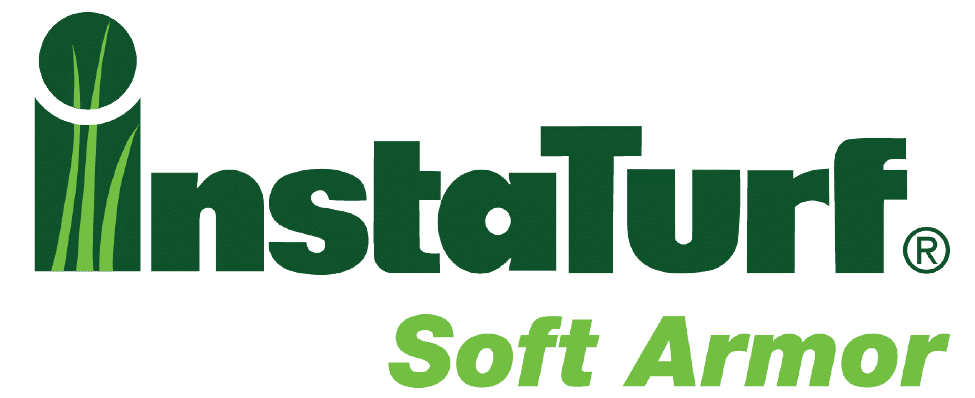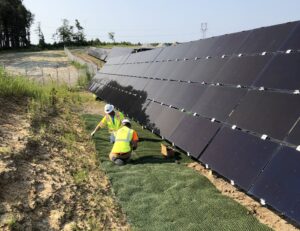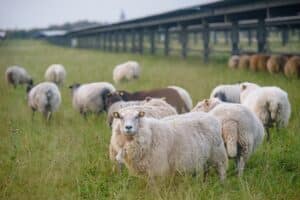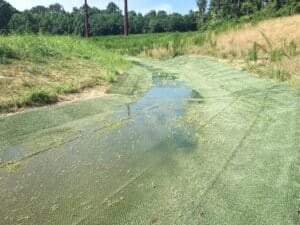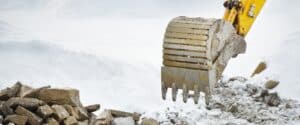The average person doesn’t think twice when looking at soil. They might associate it with agriculture or construction but hardly does the term erosion control instantly come to mind. Soil is actually quite a complex subject. Land is continuously affected by human activity and the natural world. Every rainfall, accumulation of water, or powerful wind makes minimal and gradual changes to the soil. This can especially be enhanced in areas that experience extreme weather conditions or human manipulation. These changes can alter landscapes and cause pollution from water and sediment runoff. In order to minimize the effects of erosion, people have come up with numerous methods for reducing its effects. However, erosion control practices are not a one size fits all solution. Different products are utilized in different situations. This article looks at a type of product that helps prevent erosion under severe flow conditions – turf reinforcement mats (TRM).
What Are Turf Reinforcement Mats (TRMs)?
Turf reinforcement mats are a type of rolled erosion control product (RECP) that is meant for long term soil protection. TRMs are constructed out of UV resistant and non-degradable, geosynthetic fibers, nets, filaments, wire mesh, and/or other elements that are processed into a three-dimensional matrix of a certain thickness. TRMs, just like other forms of rolled erosion control products (RECPs), come in various types. While the majority are made solely from synthetic materials, there are some that have organic components in them. When choosing TRMs with organic materials, keep in mind the natural fibers are there to help establish vegetation and will not help with long term vegetation reinforcement. The supporting structure of a TRM is always a non-degradable material.
TRMs Vs. Temporary RECPs
There are numerous rolled erosion control products available. Selecting the right product is all about knowing what you want to achieve and what area you are trying to protect. You must consider whether or not natural, unreinforced vegetation will withstand the long term water flows it will be exposed to on the site. If unreinforced vegetation is sufficient based on the design flow conditions, a temporary erosion control solution such as a Mulch Control Net (MCN), Open Weave Textile (OWT), or Erosion Control Blanket (ECB), may be the most cost-effective solution. On the other hand, If the design flow conditions will exceed the limits of natural vegetation (2.0 – 7.5 lbs/sf permissible shear stress),a permanent solution such as a TRM, that will establish as well as reinforce vegetation, is likely the best alternative.
TRMs are usually the best option in areas that experience, or are expected to experience, a lot of concentrated runoff and flow-induced shear stress. TRMs are designed to provide some level of immediate, pre-vegetated erosion protection and to increase the erosion resistance of established vegetation. Once in place and well vegetated, they are a durable and effective protective measure that is considerably more erosion resistant than vegetation alone. That said, some TRMs, such as the new InstaTurf ShearForce high flow erosion control products from GrassWorx, actually provide immediate, pre-vegetated erosion protection on par with fully vegetated conventional TRMs.
How Turf Reinforcements Mats Provide a Permanent Solution
Whichever turf reinforcement mat you choose, there are certain properties you need them to have. Good turf reinforcement mats provide erosion protection in multiple ways.
Protect the Soil Surface
The first thing that a TRM must do is protect the soil surface from erosion in order to get vegetation established. TRMs must hold the soil and seed in place, often under some very severe flow conditions. It’s important to note that TRMs are most susceptible to erosion damage and failure before vegetation establishment. Conventional TRMs typically have pre-vegetated permissible shear stress ratings of 3 lbs/sf, or less, as determined by ASTM D6460 large-scale unvegetated channel liner testing. Meaning if flow-induced shear stresses exceed 3 lbs/sf, a significant erosion failure can be expected. Once fully vegetated, the permissible shear increases substantially to 12 lbs/sf or more. However, it can often take 6 to 12 months for vegetation to establish, so using conventional TRMs in high flow areas can be somewhat risky. The new InstaTurf ShearForce TRM products have resolved this issue by actually providing 12 lbs/sf or more of shear stress protection, even without vegetation. These products essentially deliver the long term performance of TRM-reinforced vegetation, from day one of installation. This substantially increased level of immediate erosion resistance drastically reduces the risk of erosion failures before and during vegetation establishment.
Establishing Vegetation
One of the main goals of TRMs, and most other RECPs, is to help establish a natural vegetative cover. Vegetation not only provides additional cover for the soil, it also affords shade for the TRM to reduce its long term exposure to sunlight and potential for UV degradation. Furthermore, the root systems of vegetation play a vital role in consolidating and permanently stabilizing the underlying soil base against erosion. Therefore, effective TRMs have enough open space in their structures to allow for dense vegetation growth. Some tightly woven TRMs and High-Performance TRMs (HPTRMs) have shown to inhibit emergence of vegetation stems and leaves through their structures. These TRMs should typically be installed with the soil and seed, or sod, on top of their structures, as roots will penetrate their tightly woven matrices much more easily than plant stems.
Does This Mean You Have To Wait For Vegetation Establishment When Using TRMs?
As you can see, turf reinforcement mats are designed to help establish and reinforce vegetation, hence the name. The question that many people have after finding out how conventional TRMs work is – does this mean they are ineffective until vegetation is established? The simple answer to that is – it depends on how quickly vegetation can be established and the expected near-term flow conditions the TRM will be exposed to. If installed during a time of year when rapid vegetation establishment can be achieved, and near-term flow-induced shear stresses are not expected to exceed the unvegetated permissible shear stress rating of the TRM (typically 3 lbs/sf or less), then a conventional TRM will likely work fine. However, for applications when and/or where quick vegetation establishment cannot be expected, such as mid-summer, late fall or winter installations, or expected near-term flow conditions will generate shear stresses exceeding 3 lbs/sf, then a conventional TRM won’t likely be adequate. The good news is, the InstaTurf ShearForce TRMs, with their much higher pre-vegetated armoring capabilities, can be used successfully under such circumstances.
In fact, with their unique design that mimics natural vegetation, ShearForce products can even provide the same level of immediate high flow erosion protection as riprap and other hard armor products.
Where Are Turf Reinforcement Mats Typically Used?
Turf reinforcement mats are used in areas where natural vegetation alone will not provide adequate soil stabilization under the expected flow conditions it will be exposed to. They are used in areas that are susceptible to considerable erosive forces and need proper stormwater management. These are areas that experience intense stormwater runoff, or places that are frequently exposed to water’s erosive action. Typical TRM applications include:
- High-flow channels and ditches
- Outfalls and down chutes
- Water diversions
- Steep slopes
- Drainage Areas
- Stream, canal, and river banks
- Shorelines
Turf reinforcement mats are a great tool when it comes to permanently controlling soil erosion and sediment. They are considered by many to be the best RECPs available, and their results show why. Take time in choosing the proper TRMs for your site to be sure you get the immediate erosion protection and long term vegetation reinforcement needed for effective site stabilization. If in doubt about using a conventional TRM due to the disparity between its unvegetated and vegetated performance, you should seriously consider the new InstaTurf Shearforce turf reinforcement mats.
